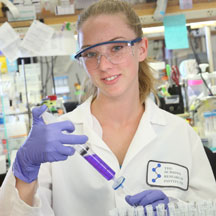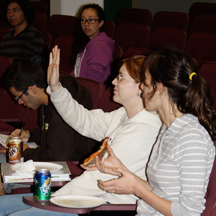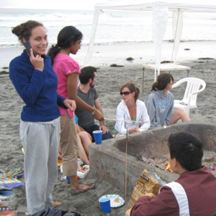

Institute Expands Summer Internship Programs
By Mika Ono and Eric Sauter
Among the eager young faces at The Scripps Research Institute's California campus this summer are a new group of interns—undergraduates participating in the Summer Undergraduate Research Fellowship (SURF) program.
"The undergraduates bring a lot of energy and enthusiasm to the labs," said Dawn Eastmond, director of education. "They are excited by the opportunity. I've already gotten a lot of positive feedback from the faculty mentors."
The seven SURF interns, whose positions are funded by the Scripps Research Graduate Office, represent top colleges and universities including Harvard, Georgetown, Spelman, Morehouse, and the University of California, San Diego. Even though this is SURF's first year, the program received 20 applications for the positions.
Now that the summer is in full swing, the SURF interns can be found conducting hands-on laboratory research on topics from DNA to natural product synthesis under the mentorship of Scripps Research faculty members, graduate students, and postdoctoral fellows. The interns also attend weekly seminars on scientific topics, learn about career opportunities in the sciences, and get away on field trips and social gatherings.
Joining Forces
For seminars and social activities, SURFers have joined forces with 11 undergraduates in another program on the California campus, the Summer Immunology and Virology Undergraduate Fellowship: An Advanced Program in Science Research Education (SINAPSE). Students participating in SINAPSE, now in its seventh year, work specifically in laboratories in the campus's Department of Immunology and Microbial Sciences. The department has funded the majority of the positions, with some contributions from Genentech Foundation.
"I think the students are enjoying the larger group to interact with," said Assistant Professor Julie Jameson, who runs the SINAPSE program. "At the same time, the seminars are still small enough so that the students have a chance to get to know faculty members who come and speak to the group."
This year's seminar topics include B cell function, the history of viruses, an introduction to molecular biology, lab techniques, toll-like receptors, and transplant immunology, as well as "hot topics in science" presentations by the interns themselves. In future years, the plan is to expand the seminar offerings so interns from the two programs will sometimes have a choice to attend lectures on varying scientific topics of interest.
One of the goals of SINAPSE—which this year received 70 applications for 11 positions—is to help students take the next step in their scientific careers, so the gatherings include a careers in science panel and a question and answer session with graduate students. Jameson notes that she hopes that the internships encourage students to consider applying to the Scripps Research Kellogg School of Science and Technology for graduate studies.
In fact, several SINAPSE alumni have attended the Kellogg School, including current graduate student Katie Podshivalova, who interned in the Jameson lab in the summer of 2006.
"In Julie Jameson's lab, I had my own project that I was completely trusted with, but at the same time Julie was always there to help," Podshivalova said. "Doing an internship at Scripps exposed me to a completely different research environment than that in an academic university, which is what I was used to. Research was the priority number one at Scripps. Even in our lecture series, after covering the basic theory, principal investigators talked about current work in their labs. The breadth of such cutting-edge research being done at one place was simply astonishing. I was also surprised by how fluid borders between departments were and how many labs worked in several different disciplines."
When it came time to choose a graduate school, Podshivalova found herself with offers from 14 institutions.
"I decided to pursue my Ph.D. at Scripps because I felt like here it would be possible to do rotations in very different fields and potentially choose a lab where a field doesn't dictate the limit, but the scientific question does. Now I am a third-year graduate student in Dan Salomon's lab, where I combine cell biology and bioinformatics to answer fundamental immunological questions."
Jumping into Research
The summer internship programs on the California campus also include a long-standing offering for high school students.
Now in its 21st year, the High School Student Research Education Program is currently hosting 25 high-achieving students, many of whom are the first in their families to be headed for college. The highly competitive program receives some 10 applications from local high school students for each position available on the Scripps California campus.
These internships roll out in three phases. First, in the spring, the high school students attend a series of enrichment tutorials arranged by Kellogg School graduate students on a variety of scientific topics. Also before arriving in the labs, the interns attend a week-long intensive lab prep "boot camp" at Miramar College, held in conjunction with interns headed to neighboring institutions Salk Institute for Biological Studies, the La Jolla Institute for Allergy and Immunology, and the University of California, San Diego, Supercomputer Center.
Next, the interns land in the lab for seven weeks of hands-on research experience. Other activities during this time include weekly get-togethers featuring lunch and lectures from Scripps Research faculty and scientific staff, career panels, and field trips to local biotech companies and other points of interest.
Finally, in the fall, the students attend a workshop to help them with the next step—the college application process.
"I'm so proud of our interns' achievements," said Educational Outreach Coordinator Marisela Chevez, who has directed the program for more than five years. "We have had high school interns as authors on scientific papers. Most recently, an intern Jorge Sanchez contributed to a paper with the Potter and Carragher labs in the July 2010 issue of Microscopy Today. Some of the interns also end up in part-time positions in the labs."
Chevez also notes that interns from the program have gone on to attend colleges including Harvard University, the California Institute of Technology, the Massachusetts Institute of Technology, as well as University of California schools.
In addition, the High School Student Research Education Program has supplied the new SURF program with excellent candidates. Three of this summer's undergraduate interns at Scripps California are alumni of the high school program.
Supporters of the 2010 high school program are: ACS SEED/Beckman Coulter, Ellen Browning Scripps Foundation, Hearst Foundation, National Institutes of Health, Shapiro Fellowship, SEMPRA Energy, and a new supporter this year, donor Eugenia Glow. San Diego Workforce Partnership and Biocom underwrote the lab-prep boot camp as part of the Life Science Summer Institute. In addition, Scripps Research and its Board of Trustees, as well individual labs, provided funding for the students.
A smaller summer internship program on the Scripps California campus is targeted at high school and middle school teachers. The teacher program, funded by an endowment established by John Diekman and his wife Susan Diekman in 2001 and monies contributed by other donors, brings several high school and middle school teachers to campus for the summer. The teachers learn modern laboratory techniques during the summer, enriching their teaching and curriculum when they return to the classroom in the fall.
Record Number of Interns at Scripps Florida
A record number of summer interns are also hard at work in the laboratories of Scripps Florida, including some 20 Palm Beach County high school students, science teachers, and college and university undergraduates, part of the annual Scripps Florida summer intern program sponsored by the William R. Kenan, Jr. Charitable Trust, a North Carolina foundation with a special interest in education.
The program, now in its sixth year, was modeled on the high school program on the California campus, pairing local high school students and science teachers with Scripps Research scientists for a six-week, hands-on experience. This is the second year that several undergraduate students who previously participated in the program as Palm Beach County high school students have returned for a longer eight-week session.
Beyond the Kenan-sponsored intern program, more than 30 college and university undergraduates will be at Scripps Florida this summer, some for academic credit, others through various external internship programs, and some working directly for individual Scripps Florida scientists.
"We had more than 130 applications this year," said Deborah Leach-Scampavia, who heads the education and outreach programs at Scripps Florida, "and a limited number of places. I wish we had more openings because there are a lot of very talented, very smart students and teachers in Palm Beach County."
More than 95 percent of Scripps Florida's summer intern program alumni are pursuing science degrees at prestigious colleges and universities in Florida and across the nation, including: Harvard, Princeton, MIT, Duke, University of Pennsylvania, Swarthmore, CalTech, Rice, Georgia Tech, Cornell, University of California Berkeley, University of Rochester, Stanford, Embry-Riddle, University of Florida, Florida Atlantic University, University of Central Florida, and University of South Florida.
In Florida, the high school student and teacher summer interns will present their research on Friday, July 23, in the Fink Auditorium on the Scripps Florida campus. All of Scripps Florida is invited to attend, as well as intern family members and friends, school district teachers, and science supervisors.
In California, the undergraduate interns will make their final presentations on Friday, August 13, from 1 to 4 PM in the Keck Amphitheater of the Beckman Building; the high school students, on Thursday, August 12, in the Timkin Auditorium of Green Hospital, from 9 AM until 4 PM. These presentations are open to the campus community.
For more information on the internship programs, see the Scripps Research Education Outreach and Community Engagement webpage.
Send comments to: mikaono[at]scripps.edu



Scripps Research
summer interns get hands-on experience in the lab, attend scientific and career-related seminars, and enjoy casual gatherings.
